The Chinese ordered the monks out but you can still help the Tibetan people here.
After the April 14th earthquake that killed more than 2,180 people and injured more that 12,000, it was amazing to see in the wake of a brutal and devastating event, so many in Tibet pulled together to provide aid and support to the regions hit the hardest. Some of the most moving images for me were Tibetan monks providing funeral services for a large number of the dead as well as supplying food and relief.
The magnitude and difficulty of the task is unimaginable.
From a Reuters report, Cairang Putso, a young monk helping to look for survivors after the quake stated that “We’re organizing ourselves. We don’t need the government to take care of everything. It is easier for us to help Tibetan people.”
And while the cultural and political undertones of the relief effort become more apparent, Buddhist monks continue to play a crucial role in developing grassroots relief operations including providing food, water and shelter for the survivors, digging through tons of rubble for survivors and providing the dead with proper funerals. If for a moment you believe that this is an easy or offhand task please check out the pictures posted here. Even looking at the aftermath brings an array of emotions.
So now, after all this effort, why are Chinese officials ordering monasteries to recall monks from the relief effort? Monks that were among some of the first responders are now apparently being sidelined by the Chinese government and media. Is it due to a general unease with the altruism and heroics displayed during the first week after the quake?
From The Guardian UK
Yixi Luoren, the head of Gengqing monastery, said 120 of the 150 monks who went to Yushu county had left on the orders of officials in the monastery’s home prefecture of Ganzi, an area known for its strong Tibetan identity.
“The authorities didn’t tell us the reason but we assume they might have worried that there are too many people there and wanted us to come home safely,” he said.
Woeser, a Beijing-based Tibetan poet and activist, said Han and Tibetan acquaintances reported similar orders being given to other monks. “A clear reason for the order wasn’t given but it was very strict,” he said. “Local officials told them through translators in Tibetan: ‘You’ve done everything already. You’ve done too much. You have to leave Yushu now, otherwise there will be trouble.'”
Other lamas were still at work, said a monk from the Sershul monastery in Sichuan, which sent hundreds to help. “Some of the monks have returned because the rescue work is reaching an end but others are still in the quake zone delivering food,” said the monk.
A spokesman for the ministry of civil affairs told a press conference in Beijing that he was not aware of an order for monks to leave.
“After the disaster happened the central government brought in a large number of rescuers while lots of monks also participated, which can be seen in many media reports,” said Peng Chenmin “It’s a good thing, which represents the spirit of ethnic unity.”
Professor Robert Barnett, director of the modern Tibetan studies program at Columbia University, said: “China has never faced this situation before, where the monks it has demonised for 15 years as potential enemies of the state turn out to be energetic contributors to social construction and community building, the same role that the party has always claimed for itself.
“There is an opportunity here for the state finally to recognise the immense cultural resources that the monks can offer. But it will take great cultural sensitivity and compromise on both sides for that to be achieved.”
Many of the Chinese first responders were unable to cope with the extreme altitude and climate of the region as well as struggling with the Tibetan language. Many of the local monks were well aquainted with the area were able to carry out the tasks and thus saved lives.
Even in the official proceedings of the National Day of Mourning instated by the Chinese government no monks robes were to be seen. In the “official” version the monastic community had very little to do with the relief/rescue efforts with most of the media reports focusing on the efforts of military and government relief efforts. But when you speak to the people in the region, as did Radio Free Asia, you hear a completely different story. According to the Yushu native they spoke to “A number of [Chinese] troops were on the scene, but they were guiding survivors instead of helping to pull out those trapped under the rubble,” further stating that “the Chinese rescue workers helped mainly at official Chinese buildings that had collapsed. Residents where predominantly Tibetans live did not receive immediate help.”
Instead, it was monks from nearby monasteries that were carrying out most of the civilian rescue work, despite warnings from the troops that the area’s dam reservoir might crumble and lead to flash flooding. The monks put their lives on the line to help. That may be what the Chinese government is most scared of. For years, the Tibetan monks have been demonized by state media agencies and arrested as troublemakers and seperatists, only to now rise up and help their fellows in a time of need.
From the Associated Press
Tsebtrim, an ethnic Tibetan who works as a translator in Yushu, the county in Qinghai province hit hardest by the April 14 quake, was among thousands left homeless. He recalls heading to the horse racing grounds shortly after the earthquake with hundreds of others who heard it would be a safe place if the local dam broke.
http://www.youtube.com/watch?v=YM0firEENYM&annotation_id=annotation_579799&feature=iv“There were these monks from Sichuan’s Ganzi who had put up all these tents, 100 tents, in just a couple of hours and they provided drinks and food,” said Tsebtrim, 31, who like many Tibetans has one name. “That night, a lot of people didn’t have a place to stay so I am really glad those monks showed up.”
In the days that followed, Tsebtrim saw monks digging through rubble for survivors or bodies, first alone and then with Chinese soldiers. He also saw them handing out food and medicine.
“It really impressed me a lot,” he said during an interview from Yushu, where he is helping run an aid station.
http://www.youtube.com/watch?v=T1kXmHTMGOk&feature=related</a>
The following photos are from the Kyegu Monastery’s Picasa page showing the aid that the local monastics provided immediately after the quake and in the ensueing days. The page consists of nearly 1000 pictures of which I picked out some of the most representative ones.




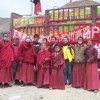
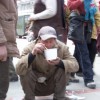
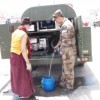
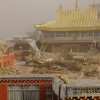

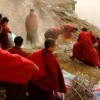
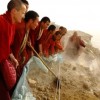
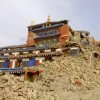
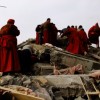


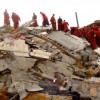

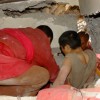



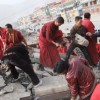
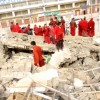

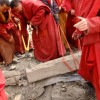



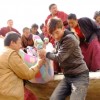
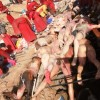
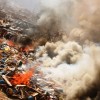
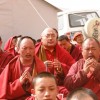

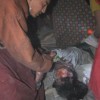

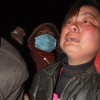
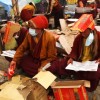

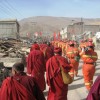
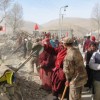

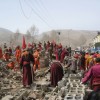


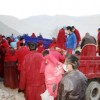
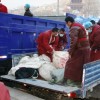
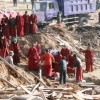
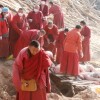
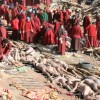
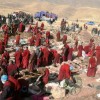
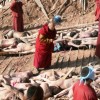


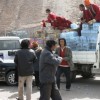









Read 5 comments and reply